Budget Management Report: Budgetary Controls and Variance Strategies
VerifiedAdded on 2023/01/10
|14
|4683
|97
Report
AI Summary
This report provides a comprehensive analysis of budget management, focusing on the context of HTC Corporation. It begins by outlining the importance of both long-term and short-term budgetary plans, emphasizing their role in achieving organizational goals and managing cash flow. The report then delves into the relationship between functional departments and responsibility centers, highlighting the interconnectedness necessary for effective business operations. Internal and external sources of information used to determine cost, price, and demand are examined. Furthermore, the report explores strategies for managing budget variances, detailing the importance of variance analysis and control mechanisms to optimize business performance. The discussion includes the different types of costs, their use in business planning and control, and the methods and techniques employed to calculate these costs. The report concludes by synthesizing the key findings and emphasizing the critical role of effective budget management in achieving financial success.
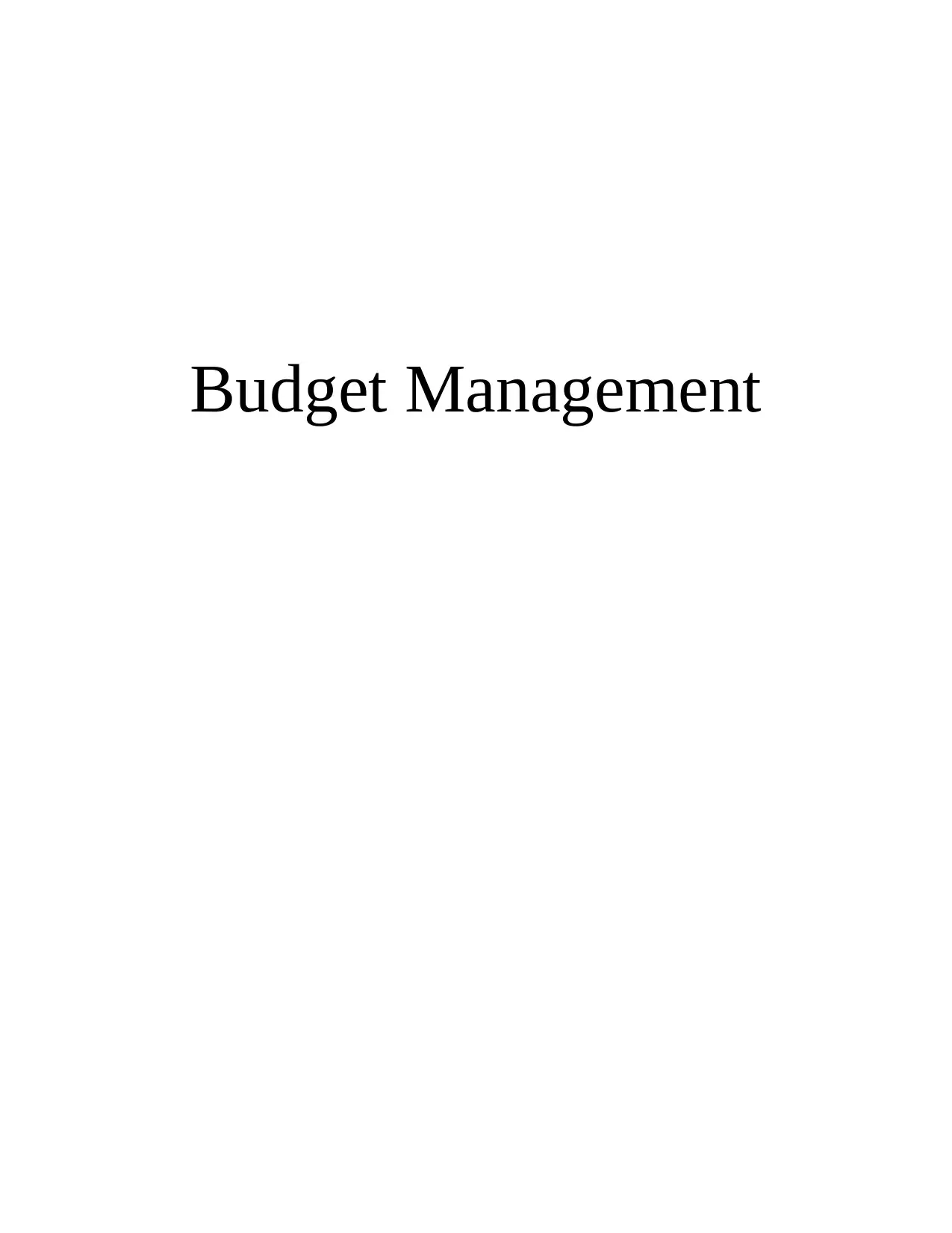
Budget Management
Paraphrase This Document
Need a fresh take? Get an instant paraphrase of this document with our AI Paraphraser
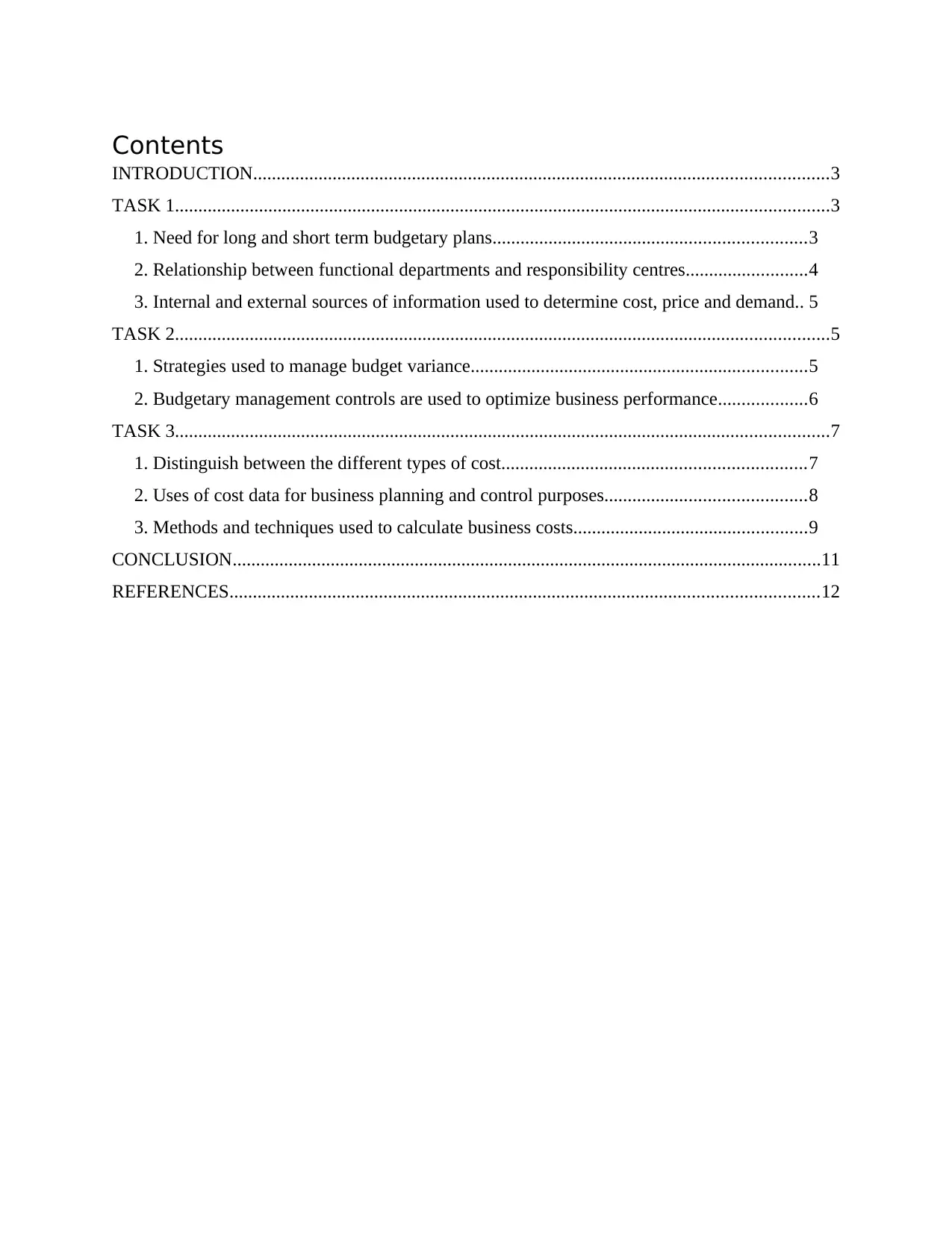
Contents
INTRODUCTION...........................................................................................................................3
TASK 1............................................................................................................................................3
1. Need for long and short term budgetary plans...................................................................3
2. Relationship between functional departments and responsibility centres..........................4
3. Internal and external sources of information used to determine cost, price and demand.. 5
TASK 2............................................................................................................................................5
1. Strategies used to manage budget variance........................................................................5
2. Budgetary management controls are used to optimize business performance...................6
TASK 3............................................................................................................................................7
1. Distinguish between the different types of cost.................................................................7
2. Uses of cost data for business planning and control purposes...........................................8
3. Methods and techniques used to calculate business costs..................................................9
CONCLUSION..............................................................................................................................11
REFERENCES..............................................................................................................................12
INTRODUCTION...........................................................................................................................3
TASK 1............................................................................................................................................3
1. Need for long and short term budgetary plans...................................................................3
2. Relationship between functional departments and responsibility centres..........................4
3. Internal and external sources of information used to determine cost, price and demand.. 5
TASK 2............................................................................................................................................5
1. Strategies used to manage budget variance........................................................................5
2. Budgetary management controls are used to optimize business performance...................6
TASK 3............................................................................................................................................7
1. Distinguish between the different types of cost.................................................................7
2. Uses of cost data for business planning and control purposes...........................................8
3. Methods and techniques used to calculate business costs..................................................9
CONCLUSION..............................................................................................................................11
REFERENCES..............................................................................................................................12
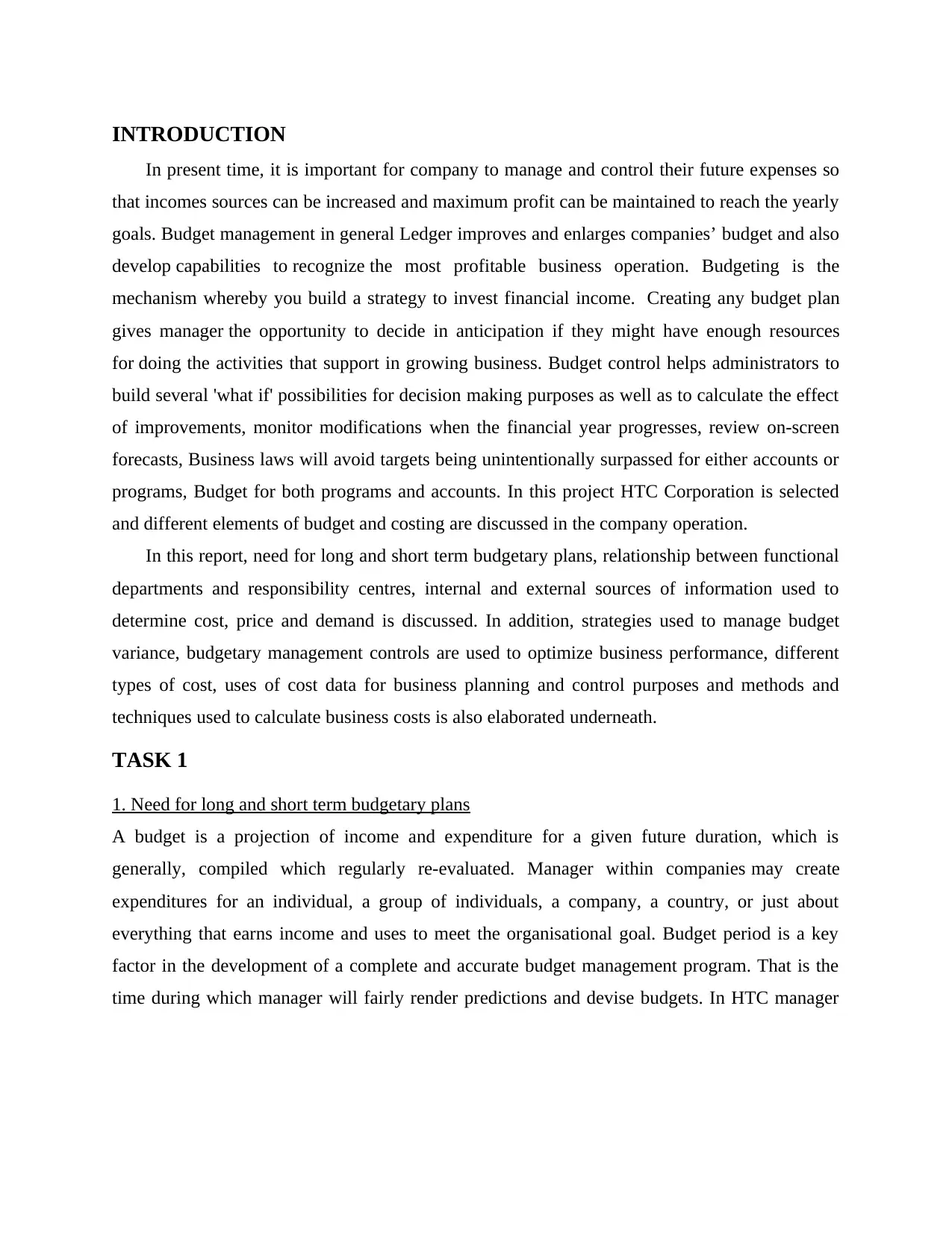
INTRODUCTION
In present time, it is important for company to manage and control their future expenses so
that incomes sources can be increased and maximum profit can be maintained to reach the yearly
goals. Budget management in general Ledger improves and enlarges companies’ budget and also
develop capabilities to recognize the most profitable business operation. Budgeting is the
mechanism whereby you build a strategy to invest financial income. Creating any budget plan
gives manager the opportunity to decide in anticipation if they might have enough resources
for doing the activities that support in growing business. Budget control helps administrators to
build several 'what if' possibilities for decision making purposes as well as to calculate the effect
of improvements, monitor modifications when the financial year progresses, review on-screen
forecasts, Business laws will avoid targets being unintentionally surpassed for either accounts or
programs, Budget for both programs and accounts. In this project HTC Corporation is selected
and different elements of budget and costing are discussed in the company operation.
In this report, need for long and short term budgetary plans, relationship between functional
departments and responsibility centres, internal and external sources of information used to
determine cost, price and demand is discussed. In addition, strategies used to manage budget
variance, budgetary management controls are used to optimize business performance, different
types of cost, uses of cost data for business planning and control purposes and methods and
techniques used to calculate business costs is also elaborated underneath.
TASK 1
1. Need for long and short term budgetary plans
A budget is a projection of income and expenditure for a given future duration, which is
generally, compiled which regularly re-evaluated. Manager within companies may create
expenditures for an individual, a group of individuals, a company, a country, or just about
everything that earns income and uses to meet the organisational goal. Budget period is a key
factor in the development of a complete and accurate budget management program. That is the
time during which manager will fairly render predictions and devise budgets. In HTC manager
In present time, it is important for company to manage and control their future expenses so
that incomes sources can be increased and maximum profit can be maintained to reach the yearly
goals. Budget management in general Ledger improves and enlarges companies’ budget and also
develop capabilities to recognize the most profitable business operation. Budgeting is the
mechanism whereby you build a strategy to invest financial income. Creating any budget plan
gives manager the opportunity to decide in anticipation if they might have enough resources
for doing the activities that support in growing business. Budget control helps administrators to
build several 'what if' possibilities for decision making purposes as well as to calculate the effect
of improvements, monitor modifications when the financial year progresses, review on-screen
forecasts, Business laws will avoid targets being unintentionally surpassed for either accounts or
programs, Budget for both programs and accounts. In this project HTC Corporation is selected
and different elements of budget and costing are discussed in the company operation.
In this report, need for long and short term budgetary plans, relationship between functional
departments and responsibility centres, internal and external sources of information used to
determine cost, price and demand is discussed. In addition, strategies used to manage budget
variance, budgetary management controls are used to optimize business performance, different
types of cost, uses of cost data for business planning and control purposes and methods and
techniques used to calculate business costs is also elaborated underneath.
TASK 1
1. Need for long and short term budgetary plans
A budget is a projection of income and expenditure for a given future duration, which is
generally, compiled which regularly re-evaluated. Manager within companies may create
expenditures for an individual, a group of individuals, a company, a country, or just about
everything that earns income and uses to meet the organisational goal. Budget period is a key
factor in the development of a complete and accurate budget management program. That is the
time during which manager will fairly render predictions and devise budgets. In HTC manager
⊘ This is a preview!⊘
Do you want full access?
Subscribe today to unlock all pages.

Trusted by 1+ million students worldwide
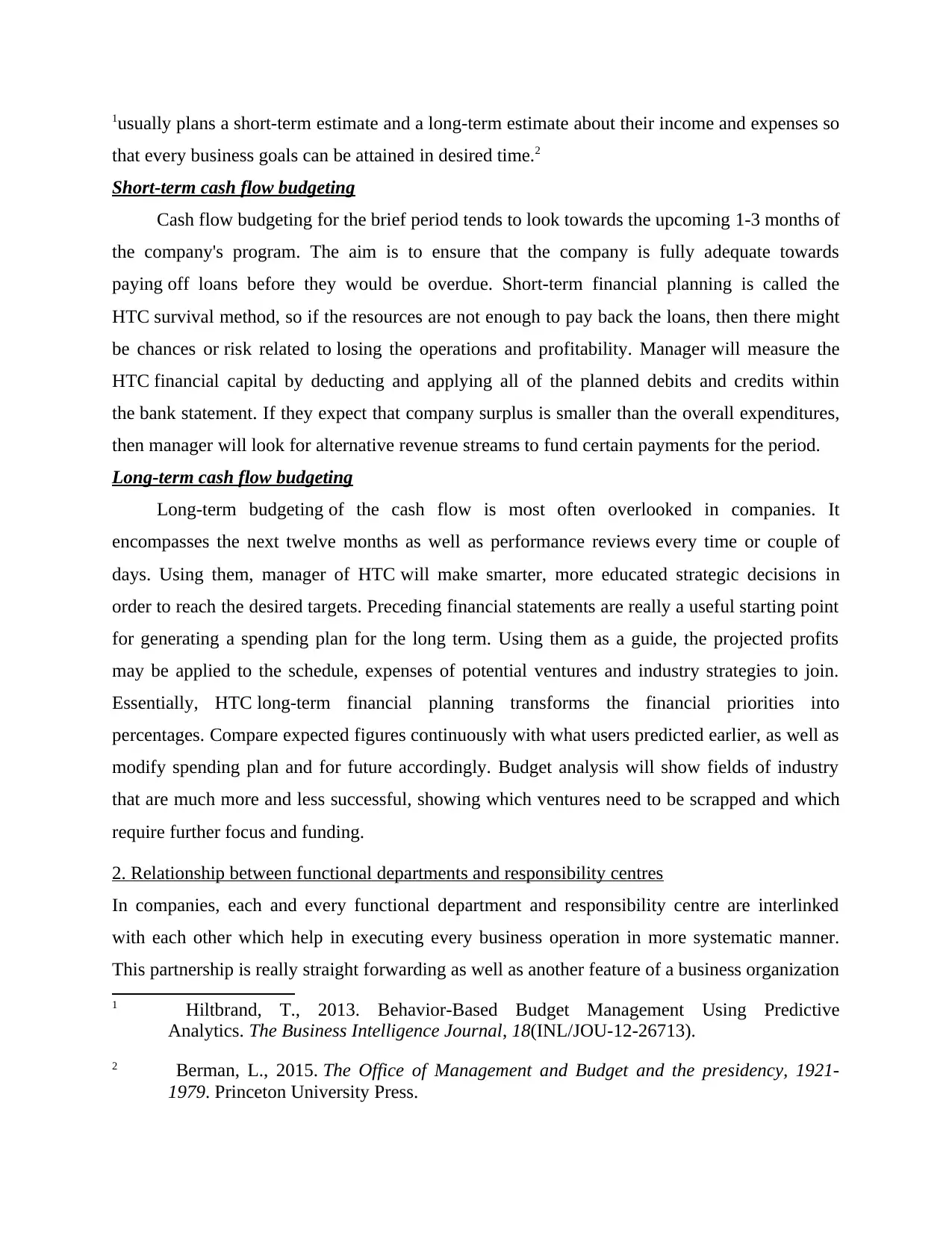
1usually plans a short-term estimate and a long-term estimate about their income and expenses so
that every business goals can be attained in desired time.2
Short-term cash flow budgeting
Cash flow budgeting for the brief period tends to look towards the upcoming 1-3 months of
the company's program. The aim is to ensure that the company is fully adequate towards
paying off loans before they would be overdue. Short-term financial planning is called the
HTC survival method, so if the resources are not enough to pay back the loans, then there might
be chances or risk related to losing the operations and profitability. Manager will measure the
HTC financial capital by deducting and applying all of the planned debits and credits within
the bank statement. If they expect that company surplus is smaller than the overall expenditures,
then manager will look for alternative revenue streams to fund certain payments for the period.
Long-term cash flow budgeting
Long-term budgeting of the cash flow is most often overlooked in companies. It
encompasses the next twelve months as well as performance reviews every time or couple of
days. Using them, manager of HTC will make smarter, more educated strategic decisions in
order to reach the desired targets. Preceding financial statements are really a useful starting point
for generating a spending plan for the long term. Using them as a guide, the projected profits
may be applied to the schedule, expenses of potential ventures and industry strategies to join.
Essentially, HTC long-term financial planning transforms the financial priorities into
percentages. Compare expected figures continuously with what users predicted earlier, as well as
modify spending plan and for future accordingly. Budget analysis will show fields of industry
that are much more and less successful, showing which ventures need to be scrapped and which
require further focus and funding.
2. Relationship between functional departments and responsibility centres
In companies, each and every functional department and responsibility centre are interlinked
with each other which help in executing every business operation in more systematic manner.
This partnership is really straight forwarding as well as another feature of a business organization
1 Hiltbrand, T., 2013. Behavior-Based Budget Management Using Predictive
Analytics. The Business Intelligence Journal, 18(INL/JOU-12-26713).
2 Berman, L., 2015. The Office of Management and Budget and the presidency, 1921-
1979. Princeton University Press.
that every business goals can be attained in desired time.2
Short-term cash flow budgeting
Cash flow budgeting for the brief period tends to look towards the upcoming 1-3 months of
the company's program. The aim is to ensure that the company is fully adequate towards
paying off loans before they would be overdue. Short-term financial planning is called the
HTC survival method, so if the resources are not enough to pay back the loans, then there might
be chances or risk related to losing the operations and profitability. Manager will measure the
HTC financial capital by deducting and applying all of the planned debits and credits within
the bank statement. If they expect that company surplus is smaller than the overall expenditures,
then manager will look for alternative revenue streams to fund certain payments for the period.
Long-term cash flow budgeting
Long-term budgeting of the cash flow is most often overlooked in companies. It
encompasses the next twelve months as well as performance reviews every time or couple of
days. Using them, manager of HTC will make smarter, more educated strategic decisions in
order to reach the desired targets. Preceding financial statements are really a useful starting point
for generating a spending plan for the long term. Using them as a guide, the projected profits
may be applied to the schedule, expenses of potential ventures and industry strategies to join.
Essentially, HTC long-term financial planning transforms the financial priorities into
percentages. Compare expected figures continuously with what users predicted earlier, as well as
modify spending plan and for future accordingly. Budget analysis will show fields of industry
that are much more and less successful, showing which ventures need to be scrapped and which
require further focus and funding.
2. Relationship between functional departments and responsibility centres
In companies, each and every functional department and responsibility centre are interlinked
with each other which help in executing every business operation in more systematic manner.
This partnership is really straight forwarding as well as another feature of a business organization
1 Hiltbrand, T., 2013. Behavior-Based Budget Management Using Predictive
Analytics. The Business Intelligence Journal, 18(INL/JOU-12-26713).
2 Berman, L., 2015. The Office of Management and Budget and the presidency, 1921-
1979. Princeton University Press.
Paraphrase This Document
Need a fresh take? Get an instant paraphrase of this document with our AI Paraphraser
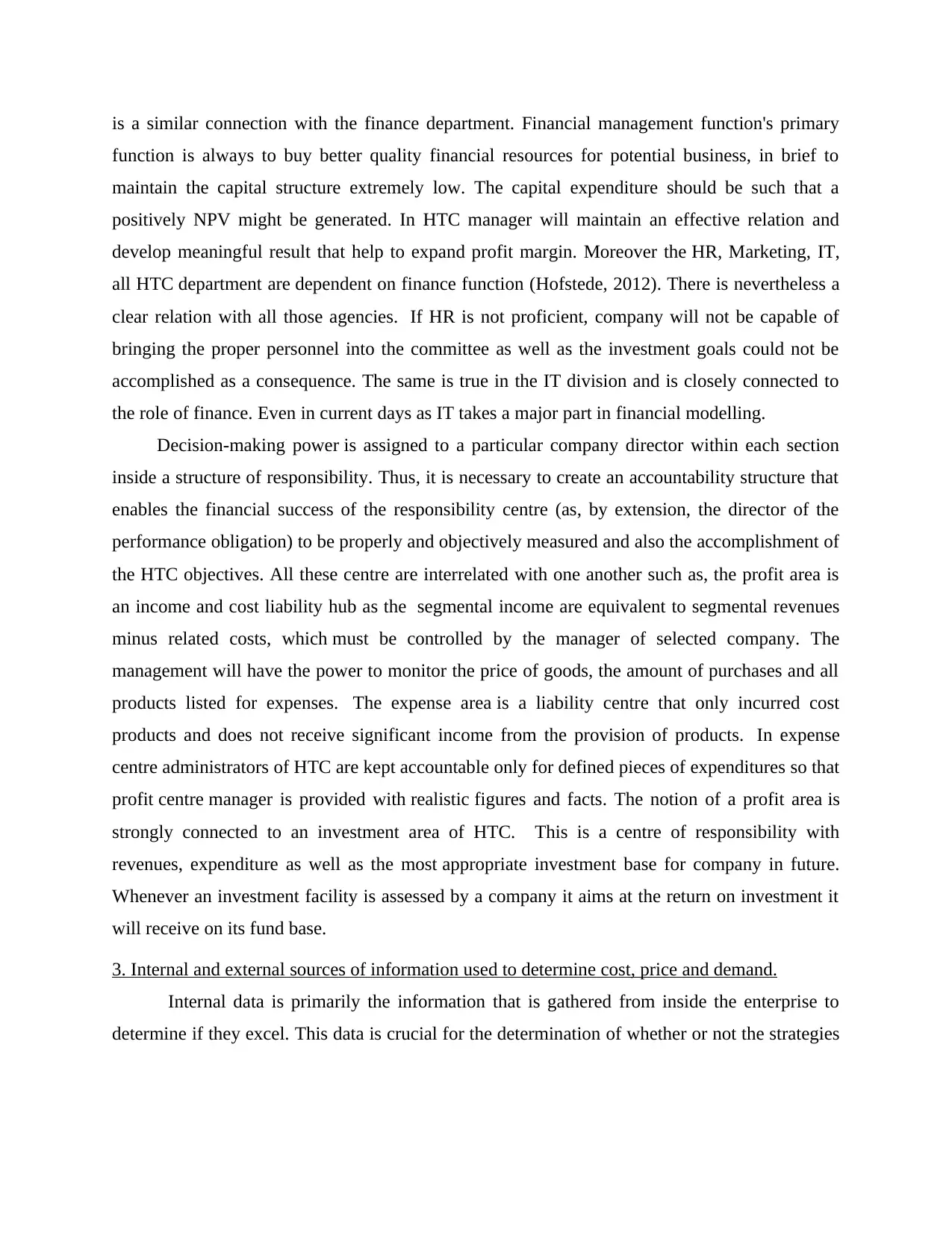
is a similar connection with the finance department. Financial management function's primary
function is always to buy better quality financial resources for potential business, in brief to
maintain the capital structure extremely low. The capital expenditure should be such that a
positively NPV might be generated. In HTC manager will maintain an effective relation and
develop meaningful result that help to expand profit margin. Moreover the HR, Marketing, IT,
all HTC department are dependent on finance function (Hofstede, 2012). There is nevertheless a
clear relation with all those agencies. If HR is not proficient, company will not be capable of
bringing the proper personnel into the committee as well as the investment goals could not be
accomplished as a consequence. The same is true in the IT division and is closely connected to
the role of finance. Even in current days as IT takes a major part in financial modelling.
Decision-making power is assigned to a particular company director within each section
inside a structure of responsibility. Thus, it is necessary to create an accountability structure that
enables the financial success of the responsibility centre (as, by extension, the director of the
performance obligation) to be properly and objectively measured and also the accomplishment of
the HTC objectives. All these centre are interrelated with one another such as, the profit area is
an income and cost liability hub as the segmental income are equivalent to segmental revenues
minus related costs, which must be controlled by the manager of selected company. The
management will have the power to monitor the price of goods, the amount of purchases and all
products listed for expenses. The expense area is a liability centre that only incurred cost
products and does not receive significant income from the provision of products. In expense
centre administrators of HTC are kept accountable only for defined pieces of expenditures so that
profit centre manager is provided with realistic figures and facts. The notion of a profit area is
strongly connected to an investment area of HTC. This is a centre of responsibility with
revenues, expenditure as well as the most appropriate investment base for company in future.
Whenever an investment facility is assessed by a company it aims at the return on investment it
will receive on its fund base.
3. Internal and external sources of information used to determine cost, price and demand.
Internal data is primarily the information that is gathered from inside the enterprise to
determine if they excel. This data is crucial for the determination of whether or not the strategies
function is always to buy better quality financial resources for potential business, in brief to
maintain the capital structure extremely low. The capital expenditure should be such that a
positively NPV might be generated. In HTC manager will maintain an effective relation and
develop meaningful result that help to expand profit margin. Moreover the HR, Marketing, IT,
all HTC department are dependent on finance function (Hofstede, 2012). There is nevertheless a
clear relation with all those agencies. If HR is not proficient, company will not be capable of
bringing the proper personnel into the committee as well as the investment goals could not be
accomplished as a consequence. The same is true in the IT division and is closely connected to
the role of finance. Even in current days as IT takes a major part in financial modelling.
Decision-making power is assigned to a particular company director within each section
inside a structure of responsibility. Thus, it is necessary to create an accountability structure that
enables the financial success of the responsibility centre (as, by extension, the director of the
performance obligation) to be properly and objectively measured and also the accomplishment of
the HTC objectives. All these centre are interrelated with one another such as, the profit area is
an income and cost liability hub as the segmental income are equivalent to segmental revenues
minus related costs, which must be controlled by the manager of selected company. The
management will have the power to monitor the price of goods, the amount of purchases and all
products listed for expenses. The expense area is a liability centre that only incurred cost
products and does not receive significant income from the provision of products. In expense
centre administrators of HTC are kept accountable only for defined pieces of expenditures so that
profit centre manager is provided with realistic figures and facts. The notion of a profit area is
strongly connected to an investment area of HTC. This is a centre of responsibility with
revenues, expenditure as well as the most appropriate investment base for company in future.
Whenever an investment facility is assessed by a company it aims at the return on investment it
will receive on its fund base.
3. Internal and external sources of information used to determine cost, price and demand.
Internal data is primarily the information that is gathered from inside the enterprise to
determine if they excel. This data is crucial for the determination of whether or not the strategies
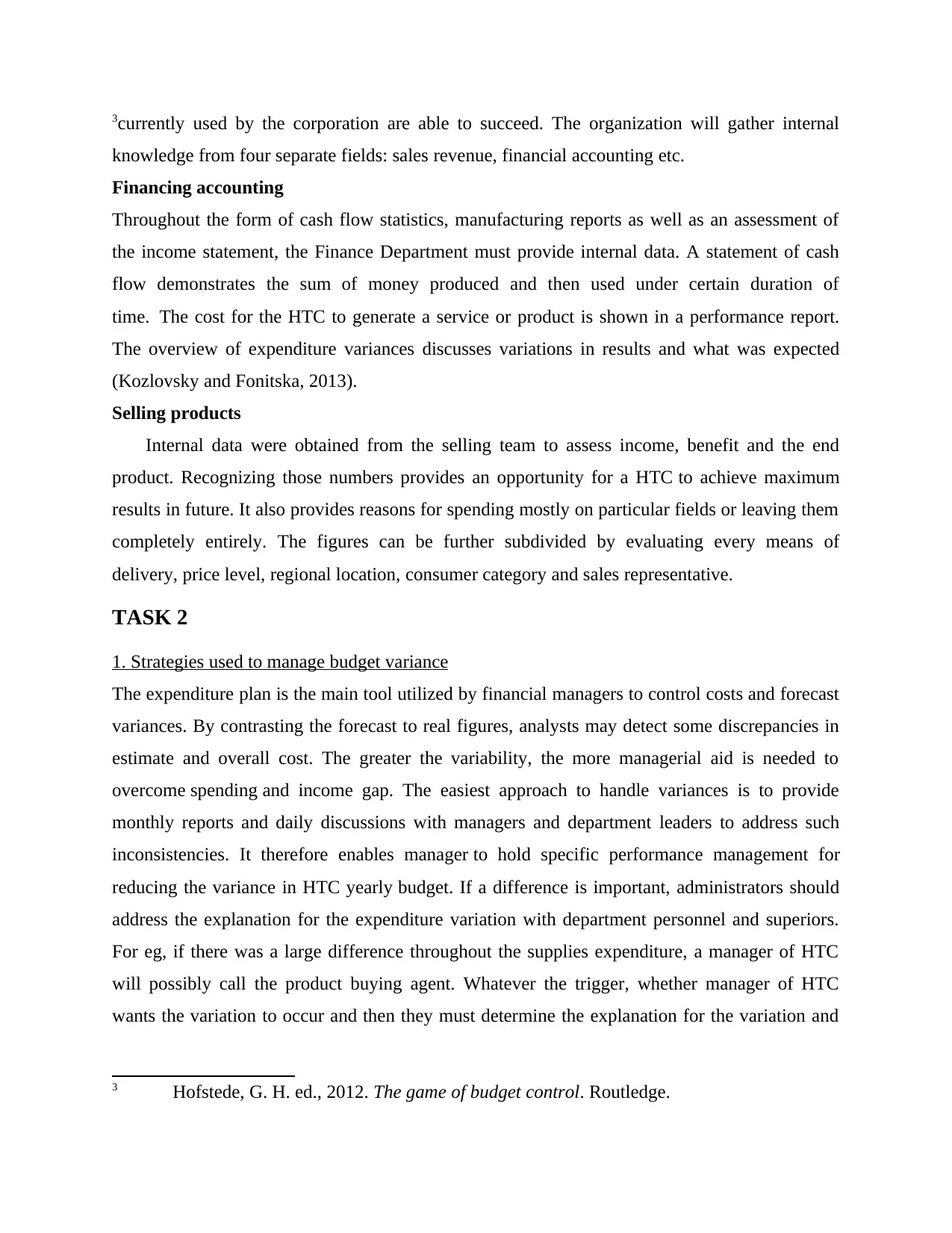
3currently used by the corporation are able to succeed. The organization will gather internal
knowledge from four separate fields: sales revenue, financial accounting etc.
Financing accounting
Throughout the form of cash flow statistics, manufacturing reports as well as an assessment of
the income statement, the Finance Department must provide internal data. A statement of cash
flow demonstrates the sum of money produced and then used under certain duration of
time. The cost for the HTC to generate a service or product is shown in a performance report.
The overview of expenditure variances discusses variations in results and what was expected
(Kozlovsky and Fonitska, 2013).
Selling products
Internal data were obtained from the selling team to assess income, benefit and the end
product. Recognizing those numbers provides an opportunity for a HTC to achieve maximum
results in future. It also provides reasons for spending mostly on particular fields or leaving them
completely entirely. The figures can be further subdivided by evaluating every means of
delivery, price level, regional location, consumer category and sales representative.
TASK 2
1. Strategies used to manage budget variance
The expenditure plan is the main tool utilized by financial managers to control costs and forecast
variances. By contrasting the forecast to real figures, analysts may detect some discrepancies in
estimate and overall cost. The greater the variability, the more managerial aid is needed to
overcome spending and income gap. The easiest approach to handle variances is to provide
monthly reports and daily discussions with managers and department leaders to address such
inconsistencies. It therefore enables manager to hold specific performance management for
reducing the variance in HTC yearly budget. If a difference is important, administrators should
address the explanation for the expenditure variation with department personnel and superiors.
For eg, if there was a large difference throughout the supplies expenditure, a manager of HTC
will possibly call the product buying agent. Whatever the trigger, whether manager of HTC
wants the variation to occur and then they must determine the explanation for the variation and
3 Hofstede, G. H. ed., 2012. The game of budget control. Routledge.
knowledge from four separate fields: sales revenue, financial accounting etc.
Financing accounting
Throughout the form of cash flow statistics, manufacturing reports as well as an assessment of
the income statement, the Finance Department must provide internal data. A statement of cash
flow demonstrates the sum of money produced and then used under certain duration of
time. The cost for the HTC to generate a service or product is shown in a performance report.
The overview of expenditure variances discusses variations in results and what was expected
(Kozlovsky and Fonitska, 2013).
Selling products
Internal data were obtained from the selling team to assess income, benefit and the end
product. Recognizing those numbers provides an opportunity for a HTC to achieve maximum
results in future. It also provides reasons for spending mostly on particular fields or leaving them
completely entirely. The figures can be further subdivided by evaluating every means of
delivery, price level, regional location, consumer category and sales representative.
TASK 2
1. Strategies used to manage budget variance
The expenditure plan is the main tool utilized by financial managers to control costs and forecast
variances. By contrasting the forecast to real figures, analysts may detect some discrepancies in
estimate and overall cost. The greater the variability, the more managerial aid is needed to
overcome spending and income gap. The easiest approach to handle variances is to provide
monthly reports and daily discussions with managers and department leaders to address such
inconsistencies. It therefore enables manager to hold specific performance management for
reducing the variance in HTC yearly budget. If a difference is important, administrators should
address the explanation for the expenditure variation with department personnel and superiors.
For eg, if there was a large difference throughout the supplies expenditure, a manager of HTC
will possibly call the product buying agent. Whatever the trigger, whether manager of HTC
wants the variation to occur and then they must determine the explanation for the variation and
3 Hofstede, G. H. ed., 2012. The game of budget control. Routledge.
⊘ This is a preview!⊘
Do you want full access?
Subscribe today to unlock all pages.

Trusted by 1+ million students worldwide
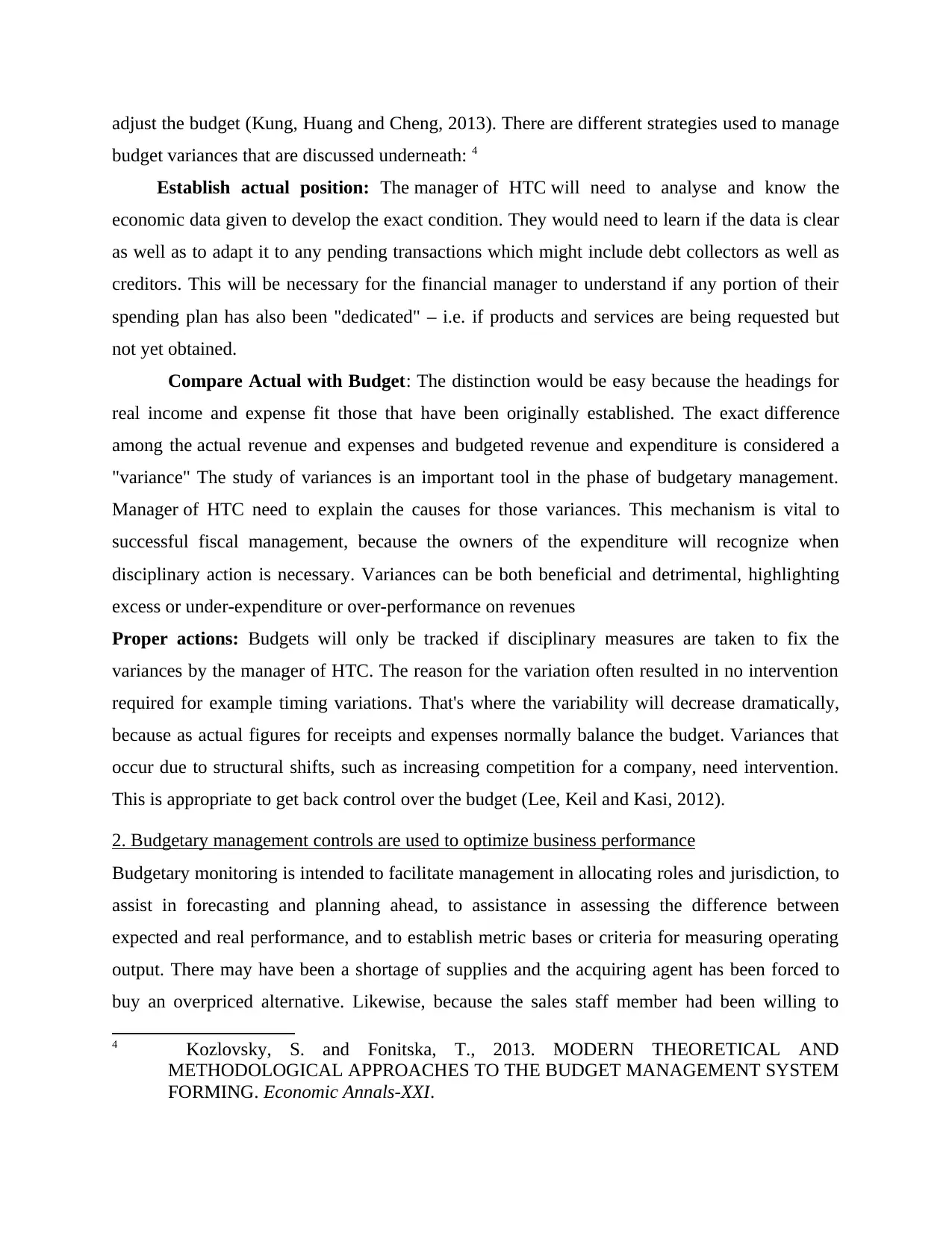
adjust the budget (Kung, Huang and Cheng, 2013). There are different strategies used to manage
budget variances that are discussed underneath: 4
Establish actual position: The manager of HTC will need to analyse and know the
economic data given to develop the exact condition. They would need to learn if the data is clear
as well as to adapt it to any pending transactions which might include debt collectors as well as
creditors. This will be necessary for the financial manager to understand if any portion of their
spending plan has also been "dedicated" – i.e. if products and services are being requested but
not yet obtained.
Compare Actual with Budget: The distinction would be easy because the headings for
real income and expense fit those that have been originally established. The exact difference
among the actual revenue and expenses and budgeted revenue and expenditure is considered a
"variance" The study of variances is an important tool in the phase of budgetary management.
Manager of HTC need to explain the causes for those variances. This mechanism is vital to
successful fiscal management, because the owners of the expenditure will recognize when
disciplinary action is necessary. Variances can be both beneficial and detrimental, highlighting
excess or under-expenditure or over-performance on revenues
Proper actions: Budgets will only be tracked if disciplinary measures are taken to fix the
variances by the manager of HTC. The reason for the variation often resulted in no intervention
required for example timing variations. That's where the variability will decrease dramatically,
because as actual figures for receipts and expenses normally balance the budget. Variances that
occur due to structural shifts, such as increasing competition for a company, need intervention.
This is appropriate to get back control over the budget (Lee, Keil and Kasi, 2012).
2. Budgetary management controls are used to optimize business performance
Budgetary monitoring is intended to facilitate management in allocating roles and jurisdiction, to
assist in forecasting and planning ahead, to assistance in assessing the difference between
expected and real performance, and to establish metric bases or criteria for measuring operating
output. There may have been a shortage of supplies and the acquiring agent has been forced to
buy an overpriced alternative. Likewise, because the sales staff member had been willing to
4 Kozlovsky, S. and Fonitska, T., 2013. MODERN THEORETICAL AND
METHODOLOGICAL APPROACHES TO THE BUDGET MANAGEMENT SYSTEM
FORMING. Economic Annals-XXI.
budget variances that are discussed underneath: 4
Establish actual position: The manager of HTC will need to analyse and know the
economic data given to develop the exact condition. They would need to learn if the data is clear
as well as to adapt it to any pending transactions which might include debt collectors as well as
creditors. This will be necessary for the financial manager to understand if any portion of their
spending plan has also been "dedicated" – i.e. if products and services are being requested but
not yet obtained.
Compare Actual with Budget: The distinction would be easy because the headings for
real income and expense fit those that have been originally established. The exact difference
among the actual revenue and expenses and budgeted revenue and expenditure is considered a
"variance" The study of variances is an important tool in the phase of budgetary management.
Manager of HTC need to explain the causes for those variances. This mechanism is vital to
successful fiscal management, because the owners of the expenditure will recognize when
disciplinary action is necessary. Variances can be both beneficial and detrimental, highlighting
excess or under-expenditure or over-performance on revenues
Proper actions: Budgets will only be tracked if disciplinary measures are taken to fix the
variances by the manager of HTC. The reason for the variation often resulted in no intervention
required for example timing variations. That's where the variability will decrease dramatically,
because as actual figures for receipts and expenses normally balance the budget. Variances that
occur due to structural shifts, such as increasing competition for a company, need intervention.
This is appropriate to get back control over the budget (Lee, Keil and Kasi, 2012).
2. Budgetary management controls are used to optimize business performance
Budgetary monitoring is intended to facilitate management in allocating roles and jurisdiction, to
assist in forecasting and planning ahead, to assistance in assessing the difference between
expected and real performance, and to establish metric bases or criteria for measuring operating
output. There may have been a shortage of supplies and the acquiring agent has been forced to
buy an overpriced alternative. Likewise, because the sales staff member had been willing to
4 Kozlovsky, S. and Fonitska, T., 2013. MODERN THEORETICAL AND
METHODOLOGICAL APPROACHES TO THE BUDGET MANAGEMENT SYSTEM
FORMING. Economic Annals-XXI.
Paraphrase This Document
Need a fresh take? Get an instant paraphrase of this document with our AI Paraphraser
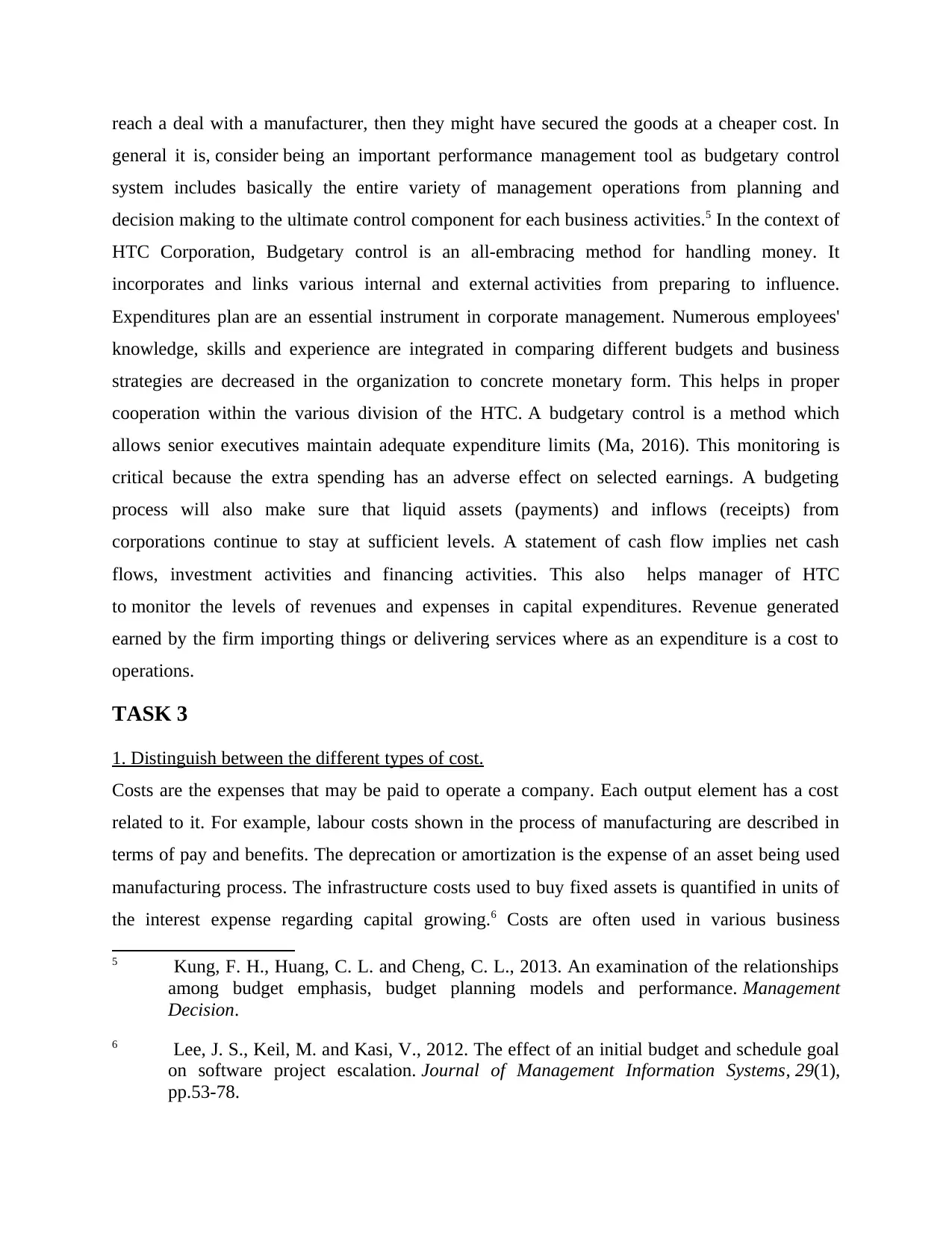
reach a deal with a manufacturer, then they might have secured the goods at a cheaper cost. In
general it is, consider being an important performance management tool as budgetary control
system includes basically the entire variety of management operations from planning and
decision making to the ultimate control component for each business activities.5 In the context of
HTC Corporation, Budgetary control is an all-embracing method for handling money. It
incorporates and links various internal and external activities from preparing to influence.
Expenditures plan are an essential instrument in corporate management. Numerous employees'
knowledge, skills and experience are integrated in comparing different budgets and business
strategies are decreased in the organization to concrete monetary form. This helps in proper
cooperation within the various division of the HTC. A budgetary control is a method which
allows senior executives maintain adequate expenditure limits (Ma, 2016). This monitoring is
critical because the extra spending has an adverse effect on selected earnings. A budgeting
process will also make sure that liquid assets (payments) and inflows (receipts) from
corporations continue to stay at sufficient levels. A statement of cash flow implies net cash
flows, investment activities and financing activities. This also helps manager of HTC
to monitor the levels of revenues and expenses in capital expenditures. Revenue generated
earned by the firm importing things or delivering services where as an expenditure is a cost to
operations.
TASK 3
1. Distinguish between the different types of cost.
Costs are the expenses that may be paid to operate a company. Each output element has a cost
related to it. For example, labour costs shown in the process of manufacturing are described in
terms of pay and benefits. The deprecation or amortization is the expense of an asset being used
manufacturing process. The infrastructure costs used to buy fixed assets is quantified in units of
the interest expense regarding capital growing.6 Costs are often used in various business
5 Kung, F. H., Huang, C. L. and Cheng, C. L., 2013. An examination of the relationships
among budget emphasis, budget planning models and performance. Management
Decision.
6 Lee, J. S., Keil, M. and Kasi, V., 2012. The effect of an initial budget and schedule goal
on software project escalation. Journal of Management Information Systems, 29(1),
pp.53-78.
general it is, consider being an important performance management tool as budgetary control
system includes basically the entire variety of management operations from planning and
decision making to the ultimate control component for each business activities.5 In the context of
HTC Corporation, Budgetary control is an all-embracing method for handling money. It
incorporates and links various internal and external activities from preparing to influence.
Expenditures plan are an essential instrument in corporate management. Numerous employees'
knowledge, skills and experience are integrated in comparing different budgets and business
strategies are decreased in the organization to concrete monetary form. This helps in proper
cooperation within the various division of the HTC. A budgetary control is a method which
allows senior executives maintain adequate expenditure limits (Ma, 2016). This monitoring is
critical because the extra spending has an adverse effect on selected earnings. A budgeting
process will also make sure that liquid assets (payments) and inflows (receipts) from
corporations continue to stay at sufficient levels. A statement of cash flow implies net cash
flows, investment activities and financing activities. This also helps manager of HTC
to monitor the levels of revenues and expenses in capital expenditures. Revenue generated
earned by the firm importing things or delivering services where as an expenditure is a cost to
operations.
TASK 3
1. Distinguish between the different types of cost.
Costs are the expenses that may be paid to operate a company. Each output element has a cost
related to it. For example, labour costs shown in the process of manufacturing are described in
terms of pay and benefits. The deprecation or amortization is the expense of an asset being used
manufacturing process. The infrastructure costs used to buy fixed assets is quantified in units of
the interest expense regarding capital growing.6 Costs are often used in various business
5 Kung, F. H., Huang, C. L. and Cheng, C. L., 2013. An examination of the relationships
among budget emphasis, budget planning models and performance. Management
Decision.
6 Lee, J. S., Keil, M. and Kasi, V., 2012. The effect of an initial budget and schedule goal
on software project escalation. Journal of Management Information Systems, 29(1),
pp.53-78.
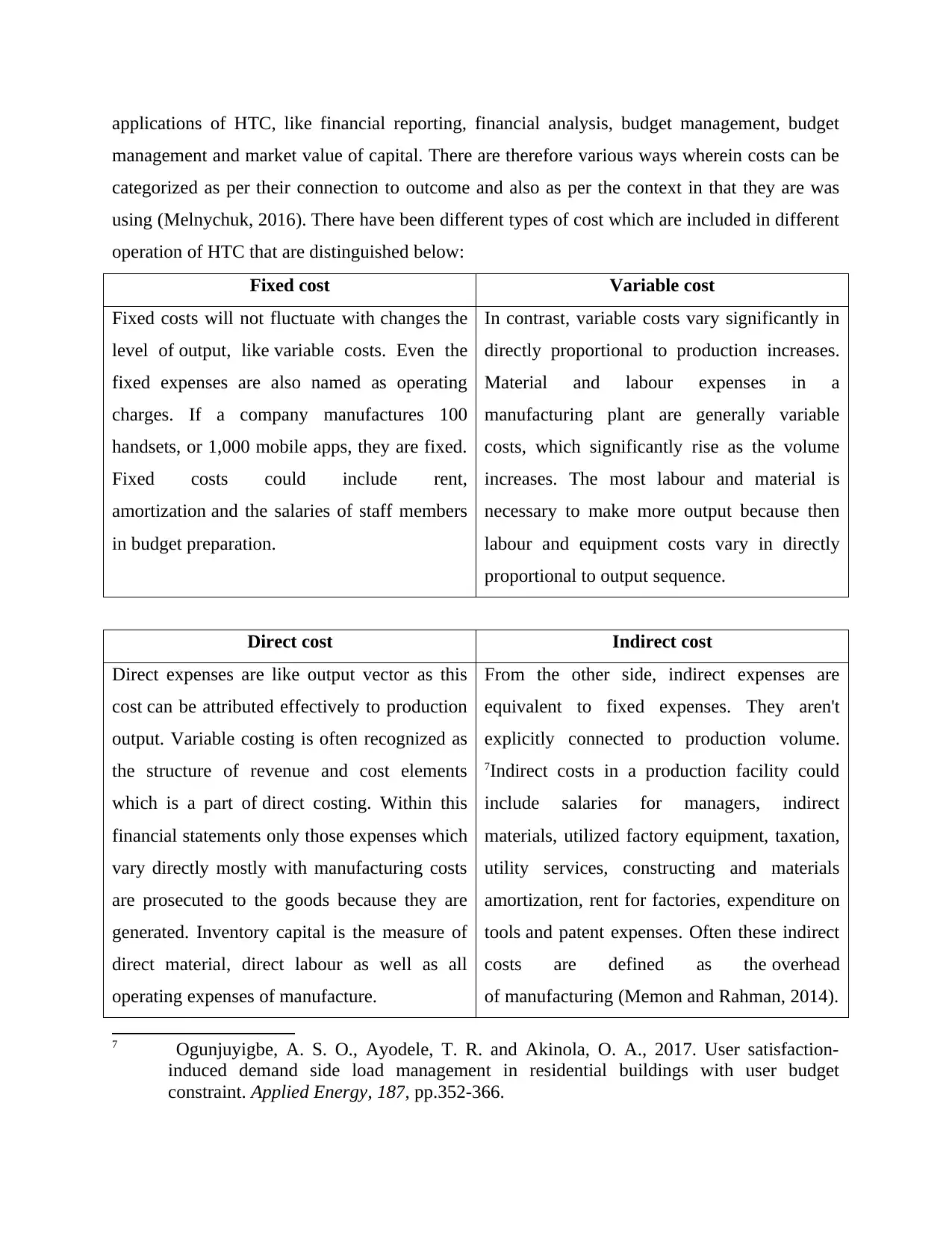
applications of HTC, like financial reporting, financial analysis, budget management, budget
management and market value of capital. There are therefore various ways wherein costs can be
categorized as per their connection to outcome and also as per the context in that they are was
using (Melnychuk, 2016). There have been different types of cost which are included in different
operation of HTC that are distinguished below:
Fixed cost Variable cost
Fixed costs will not fluctuate with changes the
level of output, like variable costs. Even the
fixed expenses are also named as operating
charges. If a company manufactures 100
handsets, or 1,000 mobile apps, they are fixed.
Fixed costs could include rent,
amortization and the salaries of staff members
in budget preparation.
In contrast, variable costs vary significantly in
directly proportional to production increases.
Material and labour expenses in a
manufacturing plant are generally variable
costs, which significantly rise as the volume
increases. The most labour and material is
necessary to make more output because then
labour and equipment costs vary in directly
proportional to output sequence.
Direct cost Indirect cost
Direct expenses are like output vector as this
cost can be attributed effectively to production
output. Variable costing is often recognized as
the structure of revenue and cost elements
which is a part of direct costing. Within this
financial statements only those expenses which
vary directly mostly with manufacturing costs
are prosecuted to the goods because they are
generated. Inventory capital is the measure of
direct material, direct labour as well as all
operating expenses of manufacture.
From the other side, indirect expenses are
equivalent to fixed expenses. They aren't
explicitly connected to production volume.
7Indirect costs in a production facility could
include salaries for managers, indirect
materials, utilized factory equipment, taxation,
utility services, constructing and materials
amortization, rent for factories, expenditure on
tools and patent expenses. Often these indirect
costs are defined as the overhead
of manufacturing (Memon and Rahman, 2014).
7 Ogunjuyigbe, A. S. O., Ayodele, T. R. and Akinola, O. A., 2017. User satisfaction-
induced demand side load management in residential buildings with user budget
constraint. Applied Energy, 187, pp.352-366.
management and market value of capital. There are therefore various ways wherein costs can be
categorized as per their connection to outcome and also as per the context in that they are was
using (Melnychuk, 2016). There have been different types of cost which are included in different
operation of HTC that are distinguished below:
Fixed cost Variable cost
Fixed costs will not fluctuate with changes the
level of output, like variable costs. Even the
fixed expenses are also named as operating
charges. If a company manufactures 100
handsets, or 1,000 mobile apps, they are fixed.
Fixed costs could include rent,
amortization and the salaries of staff members
in budget preparation.
In contrast, variable costs vary significantly in
directly proportional to production increases.
Material and labour expenses in a
manufacturing plant are generally variable
costs, which significantly rise as the volume
increases. The most labour and material is
necessary to make more output because then
labour and equipment costs vary in directly
proportional to output sequence.
Direct cost Indirect cost
Direct expenses are like output vector as this
cost can be attributed effectively to production
output. Variable costing is often recognized as
the structure of revenue and cost elements
which is a part of direct costing. Within this
financial statements only those expenses which
vary directly mostly with manufacturing costs
are prosecuted to the goods because they are
generated. Inventory capital is the measure of
direct material, direct labour as well as all
operating expenses of manufacture.
From the other side, indirect expenses are
equivalent to fixed expenses. They aren't
explicitly connected to production volume.
7Indirect costs in a production facility could
include salaries for managers, indirect
materials, utilized factory equipment, taxation,
utility services, constructing and materials
amortization, rent for factories, expenditure on
tools and patent expenses. Often these indirect
costs are defined as the overhead
of manufacturing (Memon and Rahman, 2014).
7 Ogunjuyigbe, A. S. O., Ayodele, T. R. and Akinola, O. A., 2017. User satisfaction-
induced demand side load management in residential buildings with user budget
constraint. Applied Energy, 187, pp.352-366.
⊘ This is a preview!⊘
Do you want full access?
Subscribe today to unlock all pages.

Trusted by 1+ million students worldwide
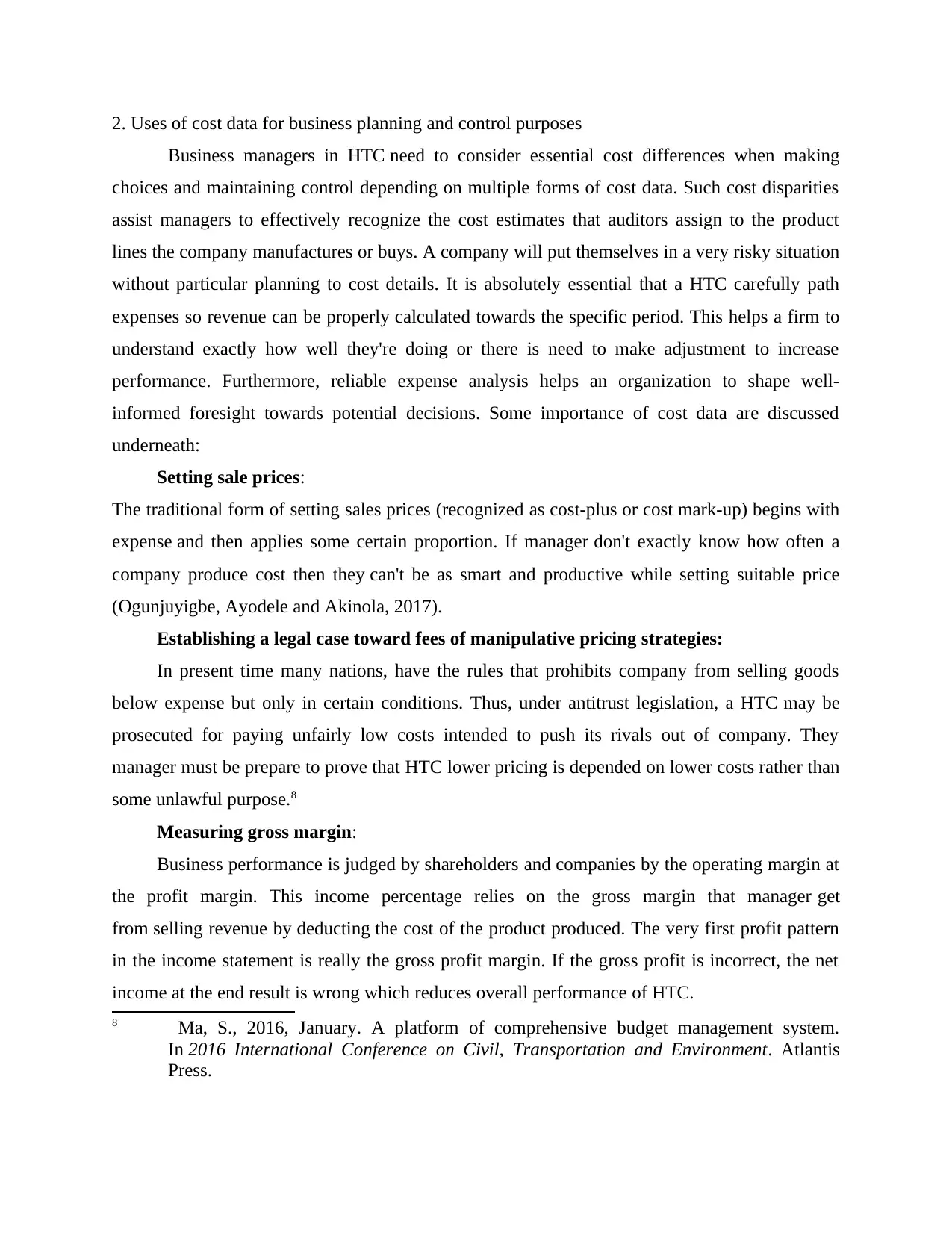
2. Uses of cost data for business planning and control purposes
Business managers in HTC need to consider essential cost differences when making
choices and maintaining control depending on multiple forms of cost data. Such cost disparities
assist managers to effectively recognize the cost estimates that auditors assign to the product
lines the company manufactures or buys. A company will put themselves in a very risky situation
without particular planning to cost details. It is absolutely essential that a HTC carefully path
expenses so revenue can be properly calculated towards the specific period. This helps a firm to
understand exactly how well they're doing or there is need to make adjustment to increase
performance. Furthermore, reliable expense analysis helps an organization to shape well-
informed foresight towards potential decisions. Some importance of cost data are discussed
underneath:
Setting sale prices:
The traditional form of setting sales prices (recognized as cost-plus or cost mark-up) begins with
expense and then applies some certain proportion. If manager don't exactly know how often a
company produce cost then they can't be as smart and productive while setting suitable price
(Ogunjuyigbe, Ayodele and Akinola, 2017).
Establishing a legal case toward fees of manipulative pricing strategies:
In present time many nations, have the rules that prohibits company from selling goods
below expense but only in certain conditions. Thus, under antitrust legislation, a HTC may be
prosecuted for paying unfairly low costs intended to push its rivals out of company. They
manager must be prepare to prove that HTC lower pricing is depended on lower costs rather than
some unlawful purpose.8
Measuring gross margin:
Business performance is judged by shareholders and companies by the operating margin at
the profit margin. This income percentage relies on the gross margin that manager get
from selling revenue by deducting the cost of the product produced. The very first profit pattern
in the income statement is really the gross profit margin. If the gross profit is incorrect, the net
income at the end result is wrong which reduces overall performance of HTC.
8 Ma, S., 2016, January. A platform of comprehensive budget management system.
In 2016 International Conference on Civil, Transportation and Environment. Atlantis
Press.
Business managers in HTC need to consider essential cost differences when making
choices and maintaining control depending on multiple forms of cost data. Such cost disparities
assist managers to effectively recognize the cost estimates that auditors assign to the product
lines the company manufactures or buys. A company will put themselves in a very risky situation
without particular planning to cost details. It is absolutely essential that a HTC carefully path
expenses so revenue can be properly calculated towards the specific period. This helps a firm to
understand exactly how well they're doing or there is need to make adjustment to increase
performance. Furthermore, reliable expense analysis helps an organization to shape well-
informed foresight towards potential decisions. Some importance of cost data are discussed
underneath:
Setting sale prices:
The traditional form of setting sales prices (recognized as cost-plus or cost mark-up) begins with
expense and then applies some certain proportion. If manager don't exactly know how often a
company produce cost then they can't be as smart and productive while setting suitable price
(Ogunjuyigbe, Ayodele and Akinola, 2017).
Establishing a legal case toward fees of manipulative pricing strategies:
In present time many nations, have the rules that prohibits company from selling goods
below expense but only in certain conditions. Thus, under antitrust legislation, a HTC may be
prosecuted for paying unfairly low costs intended to push its rivals out of company. They
manager must be prepare to prove that HTC lower pricing is depended on lower costs rather than
some unlawful purpose.8
Measuring gross margin:
Business performance is judged by shareholders and companies by the operating margin at
the profit margin. This income percentage relies on the gross margin that manager get
from selling revenue by deducting the cost of the product produced. The very first profit pattern
in the income statement is really the gross profit margin. If the gross profit is incorrect, the net
income at the end result is wrong which reduces overall performance of HTC.
8 Ma, S., 2016, January. A platform of comprehensive budget management system.
In 2016 International Conference on Civil, Transportation and Environment. Atlantis
Press.
Paraphrase This Document
Need a fresh take? Get an instant paraphrase of this document with our AI Paraphraser
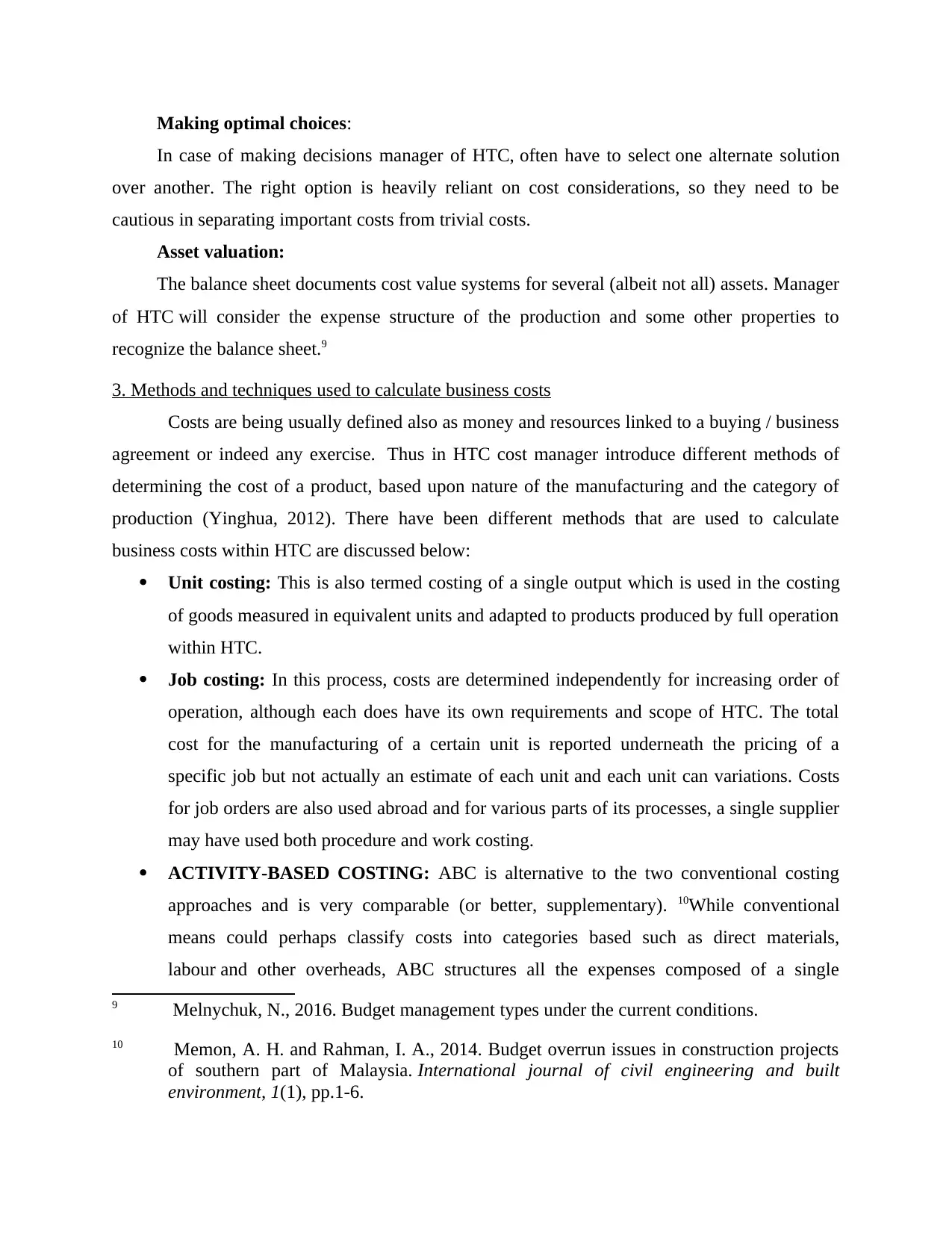
Making optimal choices:
In case of making decisions manager of HTC, often have to select one alternate solution
over another. The right option is heavily reliant on cost considerations, so they need to be
cautious in separating important costs from trivial costs.
Asset valuation:
The balance sheet documents cost value systems for several (albeit not all) assets. Manager
of HTC will consider the expense structure of the production and some other properties to
recognize the balance sheet.9
3. Methods and techniques used to calculate business costs
Costs are being usually defined also as money and resources linked to a buying / business
agreement or indeed any exercise. Thus in HTC cost manager introduce different methods of
determining the cost of a product, based upon nature of the manufacturing and the category of
production (Yinghua, 2012). There have been different methods that are used to calculate
business costs within HTC are discussed below:
Unit costing: This is also termed costing of a single output which is used in the costing
of goods measured in equivalent units and adapted to products produced by full operation
within HTC.
Job costing: In this process, costs are determined independently for increasing order of
operation, although each does have its own requirements and scope of HTC. The total
cost for the manufacturing of a certain unit is reported underneath the pricing of a
specific job but not actually an estimate of each unit and each unit can variations. Costs
for job orders are also used abroad and for various parts of its processes, a single supplier
may have used both procedure and work costing.
ACTIVITY-BASED COSTING: ABC is alternative to the two conventional costing
approaches and is very comparable (or better, supplementary). 10While conventional
means could perhaps classify costs into categories based such as direct materials,
labour and other overheads, ABC structures all the expenses composed of a single
9 Melnychuk, N., 2016. Budget management types under the current conditions.
10 Memon, A. H. and Rahman, I. A., 2014. Budget overrun issues in construction projects
of southern part of Malaysia. International journal of civil engineering and built
environment, 1(1), pp.1-6.
In case of making decisions manager of HTC, often have to select one alternate solution
over another. The right option is heavily reliant on cost considerations, so they need to be
cautious in separating important costs from trivial costs.
Asset valuation:
The balance sheet documents cost value systems for several (albeit not all) assets. Manager
of HTC will consider the expense structure of the production and some other properties to
recognize the balance sheet.9
3. Methods and techniques used to calculate business costs
Costs are being usually defined also as money and resources linked to a buying / business
agreement or indeed any exercise. Thus in HTC cost manager introduce different methods of
determining the cost of a product, based upon nature of the manufacturing and the category of
production (Yinghua, 2012). There have been different methods that are used to calculate
business costs within HTC are discussed below:
Unit costing: This is also termed costing of a single output which is used in the costing
of goods measured in equivalent units and adapted to products produced by full operation
within HTC.
Job costing: In this process, costs are determined independently for increasing order of
operation, although each does have its own requirements and scope of HTC. The total
cost for the manufacturing of a certain unit is reported underneath the pricing of a
specific job but not actually an estimate of each unit and each unit can variations. Costs
for job orders are also used abroad and for various parts of its processes, a single supplier
may have used both procedure and work costing.
ACTIVITY-BASED COSTING: ABC is alternative to the two conventional costing
approaches and is very comparable (or better, supplementary). 10While conventional
means could perhaps classify costs into categories based such as direct materials,
labour and other overheads, ABC structures all the expenses composed of a single
9 Melnychuk, N., 2016. Budget management types under the current conditions.
10 Memon, A. H. and Rahman, I. A., 2014. Budget overrun issues in construction projects
of southern part of Malaysia. International journal of civil engineering and built
environment, 1(1), pp.1-6.
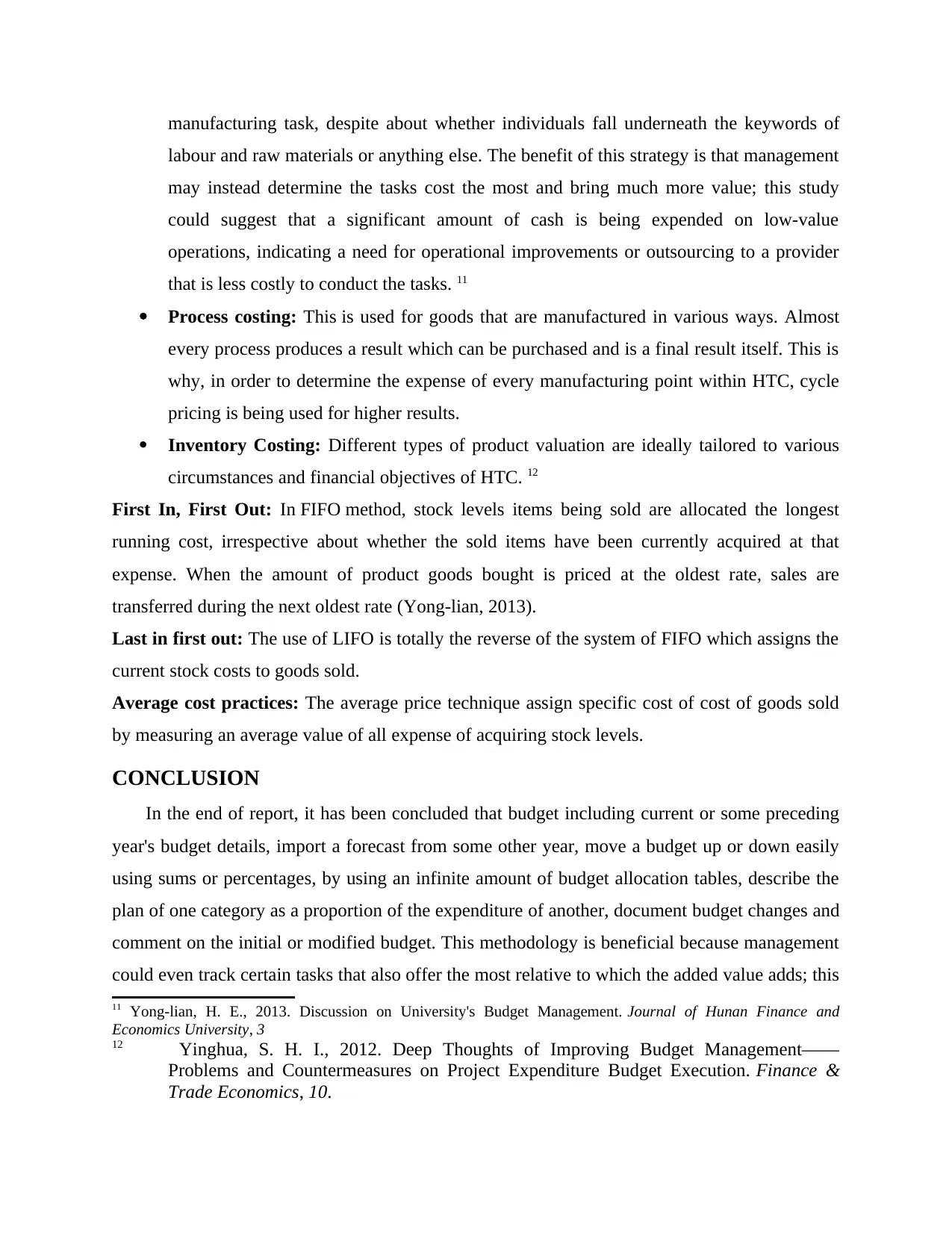
manufacturing task, despite about whether individuals fall underneath the keywords of
labour and raw materials or anything else. The benefit of this strategy is that management
may instead determine the tasks cost the most and bring much more value; this study
could suggest that a significant amount of cash is being expended on low-value
operations, indicating a need for operational improvements or outsourcing to a provider
that is less costly to conduct the tasks. 11
Process costing: This is used for goods that are manufactured in various ways. Almost
every process produces a result which can be purchased and is a final result itself. This is
why, in order to determine the expense of every manufacturing point within HTC, cycle
pricing is being used for higher results.
Inventory Costing: Different types of product valuation are ideally tailored to various
circumstances and financial objectives of HTC. 12
First In, First Out: In FIFO method, stock levels items being sold are allocated the longest
running cost, irrespective about whether the sold items have been currently acquired at that
expense. When the amount of product goods bought is priced at the oldest rate, sales are
transferred during the next oldest rate (Yong-lian, 2013).
Last in first out: The use of LIFO is totally the reverse of the system of FIFO which assigns the
current stock costs to goods sold.
Average cost practices: The average price technique assign specific cost of cost of goods sold
by measuring an average value of all expense of acquiring stock levels.
CONCLUSION
In the end of report, it has been concluded that budget including current or some preceding
year's budget details, import a forecast from some other year, move a budget up or down easily
using sums or percentages, by using an infinite amount of budget allocation tables, describe the
plan of one category as a proportion of the expenditure of another, document budget changes and
comment on the initial or modified budget. This methodology is beneficial because management
could even track certain tasks that also offer the most relative to which the added value adds; this
11 Yong-lian, H. E., 2013. Discussion on University's Budget Management. Journal of Hunan Finance and
Economics University, 3
12 Yinghua, S. H. I., 2012. Deep Thoughts of Improving Budget Management——
Problems and Countermeasures on Project Expenditure Budget Execution. Finance &
Trade Economics, 10.
labour and raw materials or anything else. The benefit of this strategy is that management
may instead determine the tasks cost the most and bring much more value; this study
could suggest that a significant amount of cash is being expended on low-value
operations, indicating a need for operational improvements or outsourcing to a provider
that is less costly to conduct the tasks. 11
Process costing: This is used for goods that are manufactured in various ways. Almost
every process produces a result which can be purchased and is a final result itself. This is
why, in order to determine the expense of every manufacturing point within HTC, cycle
pricing is being used for higher results.
Inventory Costing: Different types of product valuation are ideally tailored to various
circumstances and financial objectives of HTC. 12
First In, First Out: In FIFO method, stock levels items being sold are allocated the longest
running cost, irrespective about whether the sold items have been currently acquired at that
expense. When the amount of product goods bought is priced at the oldest rate, sales are
transferred during the next oldest rate (Yong-lian, 2013).
Last in first out: The use of LIFO is totally the reverse of the system of FIFO which assigns the
current stock costs to goods sold.
Average cost practices: The average price technique assign specific cost of cost of goods sold
by measuring an average value of all expense of acquiring stock levels.
CONCLUSION
In the end of report, it has been concluded that budget including current or some preceding
year's budget details, import a forecast from some other year, move a budget up or down easily
using sums or percentages, by using an infinite amount of budget allocation tables, describe the
plan of one category as a proportion of the expenditure of another, document budget changes and
comment on the initial or modified budget. This methodology is beneficial because management
could even track certain tasks that also offer the most relative to which the added value adds; this
11 Yong-lian, H. E., 2013. Discussion on University's Budget Management. Journal of Hunan Finance and
Economics University, 3
12 Yinghua, S. H. I., 2012. Deep Thoughts of Improving Budget Management——
Problems and Countermeasures on Project Expenditure Budget Execution. Finance &
Trade Economics, 10.
⊘ This is a preview!⊘
Do you want full access?
Subscribe today to unlock all pages.

Trusted by 1+ million students worldwide
1 out of 14
Related Documents
Your All-in-One AI-Powered Toolkit for Academic Success.
+13062052269
info@desklib.com
Available 24*7 on WhatsApp / Email
![[object Object]](/_next/static/media/star-bottom.7253800d.svg)
Unlock your academic potential
Copyright © 2020–2025 A2Z Services. All Rights Reserved. Developed and managed by ZUCOL.




